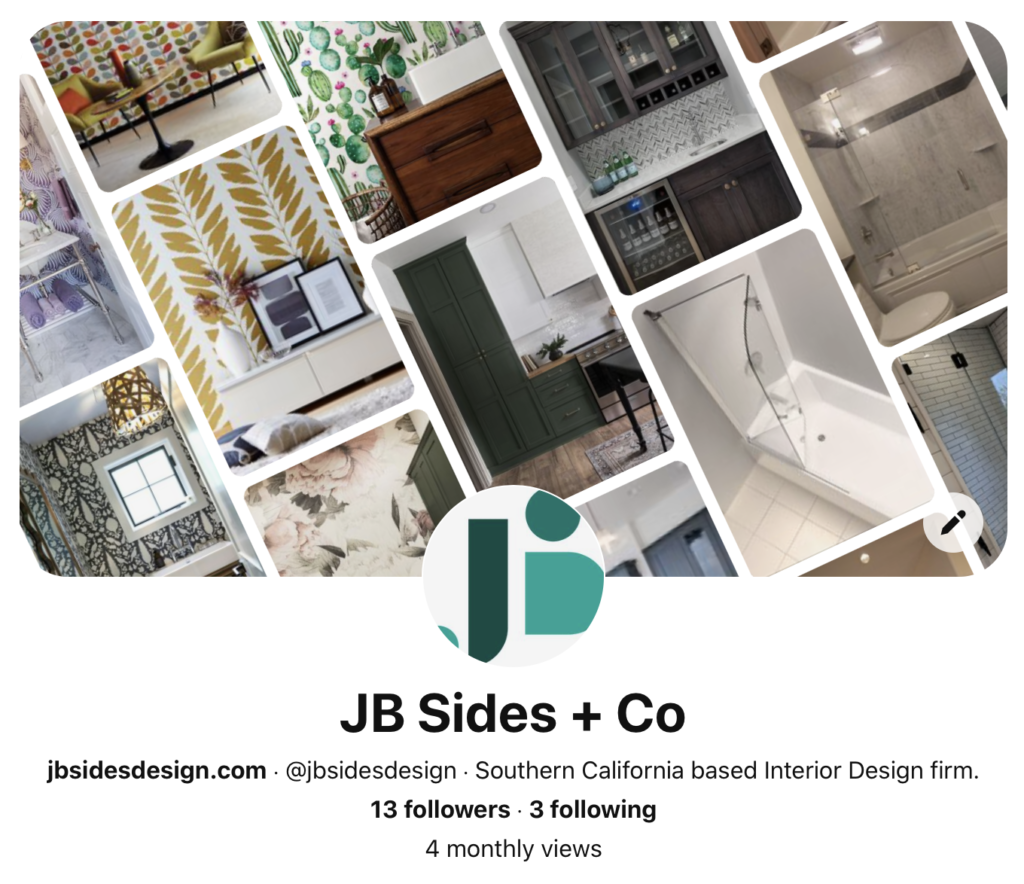Pinterest. Oh, sweet, sweet Pinterest. This miraculous space of ideas that we love to hate and hate to love. From DIY to luxury design and then some (some being an understatement), Pinterest is the convergence of design minds, ideas, trends, how-to, shopping, you name it. I was an early adopter. And by early adopter, I mean like, on the waitlist. The second my approval granted me an account, a whole new world opened to me. OB-sessed. My Trunk Club Stylist has access to my fashion board, my hairstylist and I share a board with Not Mom-bobs, I have recipes neatly organized by food group, and to this day I do my weekly meal planning via Pinterest. But all of that is neither here nor there when it comes to my design business, other than to prove the versatility (and that I am a self-proclaimed expert). We all know how to Pin, Pin, Pin away, but how do I use it in my design process?
I am 59 boards strong in my personal account. But I must add, that includes boards I am a collaborator on with my business. Never know when I might need to Pin…
I rarely use Pinterest for ideas. I know. Strange. See, I discovered early on that not all websites like to let you right-click and save their images. They do, however, let you Pin. And guess what? Pinterest lets you right-click save. HA! Don’t try to hold me down. And then Pinterest evolved to add the most handy dandy little button. Yesssss. Now, why was this so important? Remember that mood board I shared in Step 1? There’s that. And then there’s more. I haven’t shared Design Boards yet because those are further in the process, but they are pretty much the foundation for how I present to clients. Sure, you get to touch and feel as many materials as I can get my hands on, but I can’t haul that coffee table to our design presentation or lay out the entire plumbing suite on your kitchen table. Design Boards present the cohesive design in one place for a client to envision how the elements of the design fit together. There are various programs that designers use to accomplish this task, but I personally import photos into Photoshop, so yeah, I need to save these dang images! “Um, you can just take screenshots…don’t you even know how to use a computer?” Yes, of course! But, there’s still more…
I think I’ve already proven I am a Pinterest connoisseur so of course there is more to it than just saving images for Mood and Design Boards. It is how I also organize each job. “OMG, do you have clients also pin to your boards?!” Yeah, no. I will share a Pinterest Board with a client if they are particularly stuck describing a look, a concept, a scheme, etc. I will ask them to Pin some ideas so that I can get a clearer picture. Or, they may already have a board with ideas that I am happy to look over for a deeper understanding, but no, I do not share these with clients. The sole purpose is for my own organization.

The process is fairly simple. I create a private board (because it is nobody’s biz what’s swirling in this creativity until the reveal!) and then break it down into sections according to what spaces are included in the scope or by design elements. For example, a whole house, like Lake Las Vegas, is broken down into rooms. If it is just a kitchen remodel, I would likely break it down into categories like tile, appliances, flooring, furnishings, and so on. And let me tell you-when Pinterest introduced Sections…OH, HAPPY DAY! (Next step, sub-sections perhaps? Hint, hint. #prettysurethatsnottgoingtohappen)
“Ok, ok, but why Pinterest?!” Number one reason: it links back! Story time: I worked with a dear colleague who was ever trying to recall where he found that ONE fabulous chair, took a screenshot of, printed, and (physically) pinned to the design corkboard. He was notorious for forgetting to write the vendor in the corner and could never remember where he found it. And that, my friends, is where Pinterest comes in and why it is such an integral part of my process. I can literally, find everything I love for a project and nothing gets lost.
Again, different designers use different programs to accomplish this task, but I find Pinterest to be the most user friendly, widely accepted, and easy for me to accomplish this organization. Whether you are a design profession forever trying to remember where you discovered that amazing light fixture or a DIYer trying to keep your ducks in a row, Pinterest is a great tool to use not just for siphoning ideas, but organizing a space as you assess budget and implement your vision.
